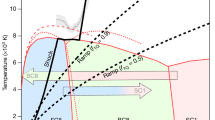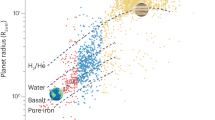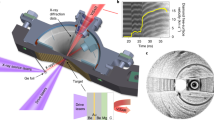Abstract
The recent discovery of more than a thousand planets outside our Solar System1,2, together with the significant push to achieve inertially confined fusion in the laboratory3, has prompted a renewed interest in how dense matter behaves at millions to billions of atmospheres of pressure. The theoretical description of such electron-degenerate matter has matured since the early quantum statistical model of Thomas and Fermi4,5,6,7,8,9,10, and now suggests that new complexities can emerge at pressures where core electrons (not only valence electrons) influence the structure and bonding of matter11. Recent developments in shock-free dynamic (ramp) compression now allow laboratory access to this dense matter regime. Here we describe ramp-compression measurements for diamond, achieving 3.7-fold compression at a peak pressure of 5 terapascals (equivalent to 50 million atmospheres). These equation-of-state data can now be compared to first-principles density functional calculations12 and theories long used to describe matter present in the interiors of giant planets, in stars, and in inertial-confinement fusion experiments. Our data also provide new constraints on mass–radius relationships for carbon-rich planets.
This is a preview of subscription content, access via your institution
Access options
Subscribe to this journal
Receive 51 print issues and online access
$199.00 per year
only $3.90 per issue
Buy this article
- Purchase on Springer Link
- Instant access to full article PDF
Prices may be subject to local taxes which are calculated during checkout



Similar content being viewed by others
References
Schneider, J., Dedieu, C., Le Sidaner, P., Savalle, R. & Zolotukhin, I. Defining and cataloging exoplanets: the exoplanet.eu database. Astron. Astrophys. 532, A79 (2011)
Seager, S., Kuchner, M., Hier-Majumder, C. A. & Militzer, B. Mass-radius relationships for solid exoplanets. Astrophys. J. 669, 1279–1297 (2007)
Edwards, M. J. et al. Progress towards ignition on the National Ignition Facility. Phys. Plasmas 20, 070501 (2013)
Thomas, L. H. The calculation of atomic fields. Math. Proc. Camb. Phil. Soc. 23, 542–548 (1927)
Dirac, P. A. M. Note on exchange phenomena in the Thomas atom. Math. Proc. Camb. Phil. Soc. 26, 376–385 (1930)
Feynman, R. P., Metropolis, N. & Teller, E. Equation of state of elements based on the generalized Fermi-Thomas theory. Phys. Rev. 75, 1561–1573 (1949)
Salpeter, E. E. & Zapolsky, H. S. Theoretical high pressure equations of state, including correlation energy. Phys. Rev. 158, 876–886 (1967)
Abrahams, A. M. & Shapiro, S. L. Cold equation of state from Thomas-Fermi-Dirac-Weizsacker theory. Phys. Rev. A 42, 2530–2538 (1990)
Lai, D., Abrahams, A. M. & Shapiro, S. L. Equation of state in metals and cold stars: evaluation of statistical models. Astrophys. J. 377, 612–628 (1991)
Correa, A. A., Benedict, L. X., Young, D. A., Schwegler, E. & Bonev, S. A. A first principles multi-phase equation of state of carbon under extreme conditions. Phys. Rev. B 78, 024101 (2008)
Neaton, J. B. & Ashcroft, N. W. Pairing in dense lithium. Nature 400, 141–144 (1999)
Martinez-Canales, M., Pickard, C. J. & Needs, R. J. Theormodynamically stable phase of carbon at multiterapascal pressures. Phys. Rev. Lett. 108, 045704 (2012)
Swift, D. C. et al. Mass-radius relationships for exoplanets. Astrophys. J. 744, 59–68 (2012)
Dubrovinsky, L., Dubrovinskaia, N., Prakapenka, V. B. & Abakumov, A. M. Implementation of micro-ball nanodiamond anvils for high-pressure studies above 6 Mbar. Nature Commun. 3, 1163 (2012)
Zel’dovich, B. & Raizer, P. Physics of Shock Waves and High-Temperature Hydrodynamic Phenomena (Dover, 2002)
Atzeni, S. & Meyer-ter-Vehn, J. The Physics of Inertial Fusion: Beam Plasma Interaction, Hydrodynamics, Hot Dense Matter (Oxford Univ. Press, 2004)
Rothman, S. D. et al. Measurement of the principle isentropes of lead and lead-antimony alloy to ∼400 kbar by quasi-isentropic compression. J. Phys. D 38, 733–740 (2005)
McWilliams, R. S. et al. Strength effects in diamond under shock compression from 0.1 to 1 TPa. Phys. Rev. B 81, 014111 (2010)
Vinet, P., Ferrante, J., Rose, J. H. & Smith, J. R. Compressibility of solids. J. Geophys. Res. 92, 9319–9325 (1987)
Birch, F. Finite elastic strain of cubic crystals. Phys. Rev. 71, 809–824 (1947)
Dewaele, A., Datchi, F., Loubeyre, P. & Mezouar, M. High pressure-high temperature equation of state of neon and diamond. Phys. Rev. B 77, 094106 (2008)
Occelli, F., Loubeyre, P. & Letoullec, R. Properties of diamond under hydrostatic pressures up to 140 GPa. Nature Mater. 2, 151–154 (2003)
Smith, R. F. et al. Time-dependence of the alpha to epsilon phase transformation in iron. J. Appl. Phys. 114, 223507 (2013)
Coppari, F. et al. Experimental evidence for a phase transition in magnesium oxide at exoplanet pressures. Nature Geosci. 6, 926–929 (2013)
Sun, J., Klug, D. D. & Martoňák, R. Structural transformations in carbon under extreme pressure: beyond diamond. J. Chem. Phys. 130, 194512 (2009)
Eggert, J. H. et al. Melting temperature of diamond at ultrahigh pressure. Nature Phys. 6, 40–43 (2010)
Madhusudhan, N., Lee, K. K. M. & Mousis, O. A possible carbon-rich interior in super-Earth 55 Cancri e. Astrophys. J. 759, L40 (2012)
Nettelmann, N. et al. Ab initio equation of state data for hydrogen, helium, and water and the internal structure of Jupiter. Astrophys. J. 683, 1217–1228 (2008)
Bailes, M. et al. Transformation of a star into a planet in the millisecond Pulsar binary. Science 333, 1717–1720 (2011)
Wagner, F. W., Sohl, F., Hussmann, H., Grott, M. & Rauer, H. Interior structure models of solid exoplanets using material laws in the infinite pressure limit. Icarus 214, 366–376 (2011)
Eremets, M. I. et al. The strength of diamond. Appl. Phys. Lett. 87, 141902 (2005)
Bradley, D. K. et al. Diamond at 800 GPa. Phys. Rev. Lett. 102, 075503 (2009)
Reichart, P. et al. Three-dimensional hydrogen microscopy in diamond. Science 306, 1537–1540 (2004)
Dawedeit, C. et al. Grain size dependent physical and chemical properties of thick CVD diamond films for high energy density physics experiments. Diamond Rel. Mater. 40, 75–81 (2013)
Celliers, P. M. et al. Line-imaging velocimeter for shock diagnostics at the Omega laser facility. Rev. Sci. Instrum. 75, 4916–4929 (2004)
Aidun, J. B. & Gupta, Y. M. Analysis of Lagrangian gauge measurements of simple and nonsimple plane waves. J. Appl. Phys. 69, 6998–7014 (1991)
Knudson, M. D., Desjarlais, M. P. & Dolan, D. H. Shock-wave exploration of the high-pressure phases of carbon. Science 322, 1822–1825 (2008)
Nagao, H. et al. Hugoniot measurement of diamond under laser shock compression up to 2 TPa. Phys. Plasmas 13, 052705 (2006)
Brygoo, S. et al. Laser-shock compression of diamond and evidence of a negative-slope melting curve. Nature Mater. 6, 274–277 (2007)
Hicks, D. G. et al. High-precision measurements of the diamond Hugoniot in and above the melt region. Phys. Rev. B 78, 174102 (2008)
McQueen, R. G., Marsh, S. P., Taylor, J. W., Fritz, J. N. & Carter, W. J. in High Velocity Impact Phenomena Ch. 7, 293–417 (Academic Press, 1970)
Herrmann, W. Constitutive equation for the dynamic compaction of ductile porous materials. J. Appl. Phys. 40, 2490–2499 (1969)
Carroll, M. M. & Holt, A. C. Static and dynamic pore-collapse relations for ductile porous materials. J. Appl. Phys. 43, 1626–1636 (1972)
Reisman, D. B., Wolfer, W. G., Elsholz, A. & Furnish, M. D. Isentropic compression of irradiated stainless steel on the Z accelerator. J. Appl. Phys. 93, 8952–8957 (2003)
Celliers, P. M. et al. Systematic uncertainties in shock-wave impedance-match analysis and the high-pressure equation of state of Al. J. Appl. Phys. 98, 113529 (2005)
Knudson, M. D. & Desjarlais, M. P. Adiabatic release measurements in α-quartz between 300 and 1200 GPa: characterization of α-quartz as a shock standard in the multimegabar regime. Phys. Rev. B 88, 184107 (2013)
Hicks, D. G. et al. Shock compression of quartz in the high-pressure fluid regime. Phys. Plasmas 12, 082702 (2005)
Benedict, L. X. et al. A multiphase equation of state for carbon addressing high pressures and temperatures. Preprint at http://arxiv.org/abs/1311.4577 (2013)
Holzapfel, W. Equations of state for ideal and real solids under strong compression. Europhys. Lett. 16, 67 (1991)
Acknowledgements
We thank the NIF staff, B. Goldstein, Ed Moses, C. Keane, the Science Use of NIF programme, C. Wild (Fraunhofer Institute for Applied Solid-State Physics, Freiburg, Germany) for preparation of the diamond targets, D. Hicks for his analysis work, and M. Millot for reanalysing published diamond Hugoniot data. This work was performed under the auspices of the US Department of Energy by Lawrence Livermore National Laboratory under contract number DE-AC52-07NA27344, with additional support from the Department of Energy, the University of California, and the Miller Institute for Basic Research in Science.
Author information
Authors and Affiliations
Contributions
R.F.S., J.H.E., D.G.B., P.M.C., J.R.P., A.E.L. and G.W.C. designed, executed and analysed the data from the ramp compression experiments. J.H.E., R.E.R., L.X.B., R.J., T.S.D., J.W. and G.W.C. performed the comparisons of experimental data to EOS models and theory. J.B., T.B. and A.V.H. were instrumental in procuring and metrologizing the diamond step samples.
Corresponding author
Ethics declarations
Competing interests
The authors declare no competing financial interests.
Extended data figures and tables
Extended Data Figure 1 Ramp-compressed diamond stress versus density compared to other high-pressure data.
NIF ramp-compression data with 1σ error bars (solid blue line) together with calculated Hugoniots (low-initial-density diamond, solid red line; standard-initial-density diamond, dotted red line) and the calculated cold curve (dashed red line)12 from DFT; a simple Mie–Grüneisen model reduction of Hugoniot data to produce an extrapolated Hugoniot (low-initial-density diamond, solid orange line; standard-initial-density diamond, dotted orange line), and cold curve (dashed orange line); Vinet19 (dot-dashed grey line), Birch-Murnaghan20 (dashed grey line), and Holzapfel49 (dotted grey line) extrapolations of 300-K diamond anvil cell data21,22. The shaded regions show the range of different models for cold curve (grey) and Hugoniot (orange) showing roughly the range of uncertainty in this ultrahigh-pressure regime. Also shown are data from shock experiments (yellow circles37, up triangles38, open pentagons (which used an Al or Mo standard)40, down triangles39, blue pentagons (which used the more accurate quartz standard)40, open squares18), isothermal static data (green circles are ruby-corrected data21,22) and the ramp-compression data of Bradley32 (solid grey line). The ramp-compression data of Bradley used full-density diamond and did not use an initial shock as in NIF data. The inset shows the calculated stress–density relations of the three NIF shots: N110308, N110516 and N110524, showing the level of repeatability between experiments.
Rights and permissions
About this article
Cite this article
Smith, R., Eggert, J., Jeanloz, R. et al. Ramp compression of diamond to five terapascals. Nature 511, 330–333 (2014). https://doi.org/10.1038/nature13526
Received:
Accepted:
Published:
Issue Date:
DOI: https://doi.org/10.1038/nature13526
This article is cited by
-
Materials under extreme conditions using large X-ray facilities
Nature Reviews Methods Primers (2023)
-
Extended X-ray absorption fine structure of dynamically-compressed copper up to 1 terapascal
Nature Communications (2023)
-
Experimental observation of open structures in elemental magnesium at terapascal pressures
Nature Physics (2022)
-
Metastability of diamond ramp-compressed to 2 terapascals
Nature (2021)
-
The data-driven future of high-energy-density physics
Nature (2021)
Comments
By submitting a comment you agree to abide by our Terms and Community Guidelines. If you find something abusive or that does not comply with our terms or guidelines please flag it as inappropriate.



